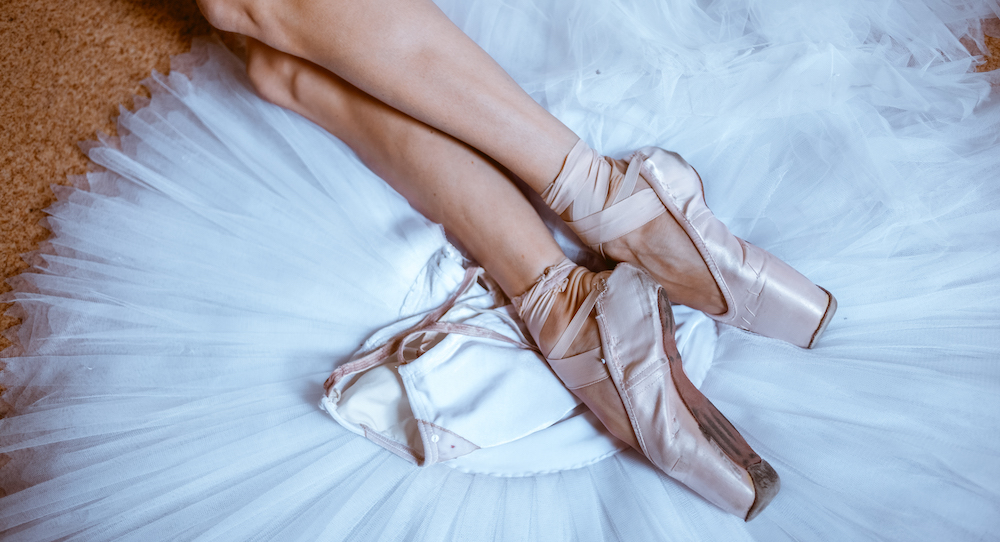Leotards
The leotard was named after the French acrobat Jules Léotard, who popularised its use in the mid-1800s.
Originally, it was a one-piece garment worn by circus performers and acrobats for ease of movement. It gained further popularity in dance and later in gymnastics and other athletic activities. Today, it’s a staple in dancewear and activewear, known for its form-fitting design and flexibility.
Ballet tights
Ballet tights, also known as ballet stockings or leggings, have a history that parallels the evolution of ballet itself. In the early years of ballet, dancers wore traditional court attire, including stockings and shoes. As ballet developed into a more codified art form in the 17th and 18th centuries, dancers began to wear tighter, more form-fitting garments to showcase their movements and lines.
The modern ballet tights we see today evolved during the 19th century. As ballet became more professionalized and performances moved from courts to theatres, dancers started wearing tighter, seamless stockings or tights to enhance their appearance and flexibility on stage. These tights were often made of silk or wool and were flesh-colored to create the illusion of bare legs.
Today, ballet tights are an essential part of a dancer’s attire, providing support, coverage, flexibility and a streamlined aesthetic. They come in various colours and materials to suit different skin tones and performance needs.
Ballet shoes
Ballet slippers, also known as ballet shoes or ballet flats, have a long history dating back to the origins of ballet in the Italian Renaissance courts during the 15th and 16th centuries. In those early days, dancers wore soft, slipper-like shoes made of silk or satin, with thin leather soles to provide some protection and grip. As ballet evolved and became more formalised, the design of ballet slippers also evolved.
In the 19th century, Marie Taglioni, a famous ballerina, popularised the use of pointe shoes, which had reinforced toes to enable dancers to balance on the tips of their toes. However, for most of the choreography, dancers still wore soft slippers. (For a look at pointe shoe history see our article, The history of dancing en pointe.)
During the 20th century, advancements in materials and manufacturing techniques led to the development of the modern ballet slipper. These slippers feature a flexible sole made of leather, canvas or satin, with a snug-fitting, stretchy upper that conforms to the shape of the foot. The split sole design, which has separate sections for the ball and heel of the foot, allows for greater flexibility and articulation.
Today, ballet slippers are an essential part of a dancer’s attire, providing comfort, support and flexibility while allowing for precise movement, easy foot articulation and expression on stage. They generally come in a ballet/theatrical light pink colour but you can now find them in various colours and styles to match different skin tones and performance requirements.
Tap shoes
The history of tap shoes traces back to the fusion of African dance traditions with European dance forms in the United States during the 19th century. African slaves brought rhythmic dance traditions with them, which blended with European dance styles to create what we now know as tap dance.
Initially, dancers used hard-soled shoes with metal plates nailed to the soles to create percussive sounds. These early tap shoes were noisy and cumbersome. However, in the mid-19th century, a breakthrough occurred when a dancer named John “Jack” Diamond began attaching metal plates directly to the soles and heels of shoes. This innovation allowed for greater flexibility and articulation in movement while producing clearer and more resonant sounds.
As tap dance gained popularity in vaudeville and musical theatre during the early 20th century, tap shoes continued to evolve. Manufacturers began producing specialised shoes with metal taps attached to the toes and heels, providing dancers with greater control over their movements and sound production.
Today, tap shoes come in various styles, including lace-up oxfords, slip-ons and character shoes, each designed to meet the specific needs of different styles of tap dance. They remain an integral part of tap dance performances, allowing dancers to express themselves rhythmically through their feet.















